English Bluebells, Spanish Bluebells & Bees
- And How To Remove Spanish Bluebells
English bluebells are fragrant, beautiful, and loved by bees. They are native to the UK, but cross breeding with Spanish bluebells poses a threat. Moreover, planting Spanish bluebells in your garden or allowing them to spread into the wild is against the law, and carries a fine.
Here you'll find information about how to spot the difference between English bluebells and Spanish bluebells, how to get rid of Spanish bluebells, and further information about the law.
Bees love English bluebells - Hyacinthoides non-scripta – and so do I! The fragrance in the woods in May, and their lovely, delicate drooping heads, not to mention the sound of busy bees as they buzz from flower to flower, is something I look forward to every year.
However, I have become increasingly concerned by the appearance of Spanish bluebells (Hyacinthoides hispanica) in my garden, and in the woods and along one of the country walks near where I live. I’m going to have to get my gardening boots on and start removing the Spanish bluebells from my garden!
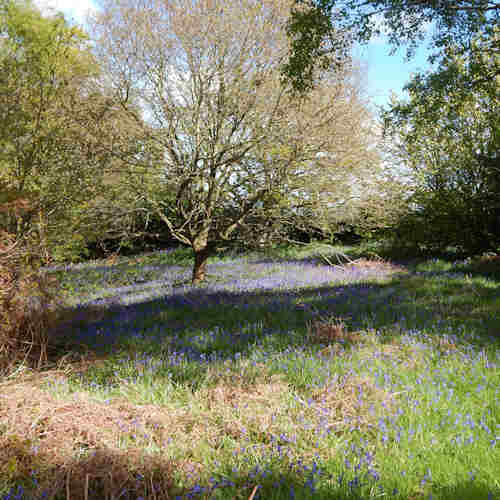 Again, woods near me - this particular site is full of English bluebells and bees.
Again, woods near me - this particular site is full of English bluebells and bees.I
didn't deliberately plant the Spanish bluebells - they hitched a lift
- I suspect - with some plants from a neighbour, and popped up in three places in my
garden (a lesson in that, I think!).
As for the few I have seen in the woods, I will contact the local warden responsible for the woods, in case the Spanish bluebells haven't been spotted yet.
Why are Spanish bluebells a problem?
I
am not against non-native species for the sake of it – it really depends on the
characteristics of the plant. Some
non-native plants provide valuable pollen and nectar for bees, (and it should be remembered that many fruit
and vegetables grown for humans – also are not native!). Unfortunately, however, the Spanish bluebell
is invasive, and it is cross breeding with the native English bluebell to the extent that there is real concern that Hyacinthoides
non-scripta could become extinct in the longer term.
But why should we care?
- English bluebells typically have a slightly earlier flowering period than their Spanish cousins, and provide a valuable early nectar source for bees and other pollinators in particular habitats. I certainly see
lots of bees on the English bluebells - you can literally hear the bees
buzzing in the fragrant English bluebell patches in the woods where I live. In contrast,
in my experience, Spanish bluebells are not as popular with
pollinators - perhaps because they are a little later, by which time, more valuable food sources are available. (Hybrids may get visits from pollinators, however, but this does not mean they are as beneficial as English bluebells, and as stated, it is an offense under English law to plant them in your garden, and you could be fined £5,000 - see below for further information).
- English bluebells provide important indicators of ancient woodland habitat, which in itself can provide valuable biodiversity indicators.
- It takes years and years for the native bluebells to increase their territory, with a seed taking about 5 years to develop into a bulb. They are fussy with regard to their habitat requirements.
In contrast, Spanish bluebells spread readily by seeds, but also by underground runners. The runners produce new bulbs. They are rather thuggish in their spreading and growth habit, and will grow and spread just about anywhere.
What's the difference between English bluebells and Spanish bluebells?
Flower Shape And Form Of Plant:
|
English bluebells:
|
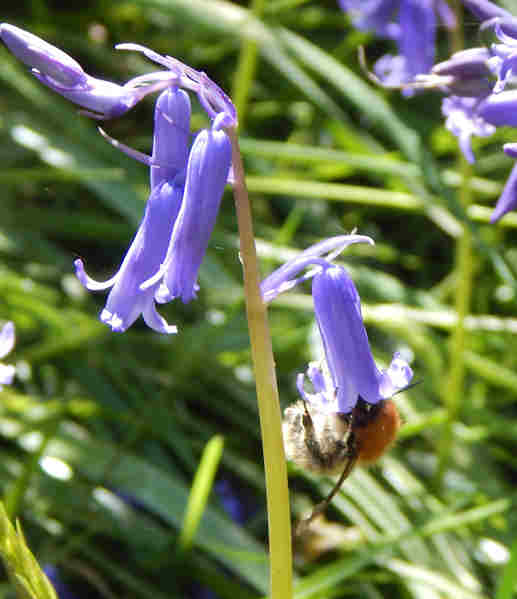 English bluebells have a more delicate appearance, with a slender, narrow bell-shaped flower than Spanish bluebells. English bluebells have a more delicate appearance, with a slender, narrow bell-shaped flower than Spanish bluebells. |
|
Spanish bluebells:
|
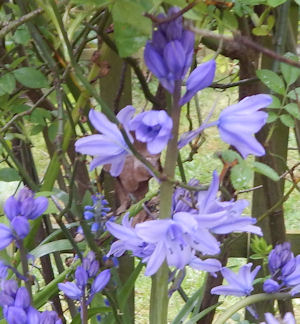 Spanish bluebells have a more open, 'star-like' shape than English bluebells. Spanish bluebells have a more open, 'star-like' shape than English bluebells. |
Leaves
the Spanish bluebell has broader, larger leaves than the English bluebell.
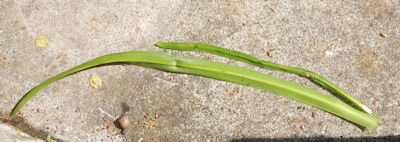 The top, narrow leaf is from the native bluebell, Hyacinthoides non-scripta, whereas the broader, larger leaf is from the Spanish bluebell, Hyacinthoides hispanica.
The top, narrow leaf is from the native bluebell, Hyacinthoides non-scripta, whereas the broader, larger leaf is from the Spanish bluebell, Hyacinthoides hispanica.Fragrance:
English bluebells: Lovely fragrance - some would describe it as cool and sweet, others may describe it as fresh and sweet. Anyway, it's very appealing (no wonder the bees love it!).
Spanish bluebells: No fragrance.
Colour
|
Spanish bluebells:
|
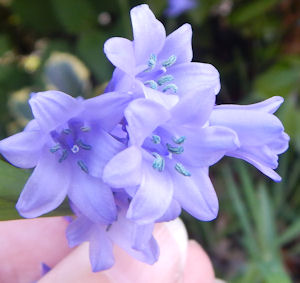 Anthers of Spanish bluebells carry blue pollen. Anthers of Spanish bluebells carry blue pollen. |
|
English bluebells:
|
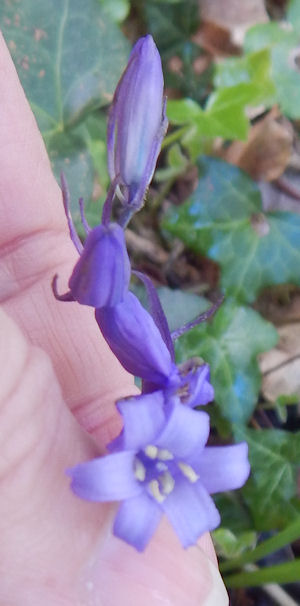 The anthers of the English bluebell carry pollen which is a pale, creamy colour. The anthers of the English bluebell carry pollen which is a pale, creamy colour. |
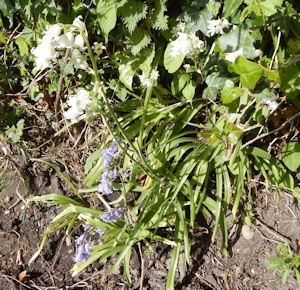 Above, white and pale blue Hyacinthoides hispanica.
Above, white and pale blue Hyacinthoides hispanica.Hybrids
Hybrids may have a combination of the above characteristics!
This means, you may, for example, come across specimens looking more like Spanish bluebells, but
- with a little scent and pale anthers and pollen;
- a drooping flower stem;
- petals curved upward at the tips.
If I found hybrids in my garden I would get rid of those too.
Spanish bluebells and the law
In the UK:
It is not an offence to have Spanish bluebells on your land (they were introduced to the UK by the Victorians).
However:
- they have been listed as a Schedule 9 species under the Wildlife and Countryside Act 1981, and;
- it is an offence to plant them, and;
- it is an offence to allow them to spread into the wild.
So, the law is a little murky in one sense (probably in recognition of the fact that they can inadvertently end up in the garden - as was the case with me), but at the very least, for the sake of the native English bluebell, then if you find Spanish bluebells in your garden,
please remove them as soon as possible. You'll need to be careful about how you dispose of them.
Never plant them intentionally.
Note that offences under the Wildlife and Countryside Act 1981 can result in possible fines and prison sentences!
According to the UK Government website:"You could be fined up to £5,000 or be sent to prison for
up to 2 years if you allow contaminated soil or plant material from any waste
you transfer to spread into the wild." (1)
Also, please note that it is an offence to remove the native wild bluebells from their habitats.
How to get rid of Spanish bluebells
The most important thing is to dig into the ground and
remove both bulbs and runners as soon as possible. This is what I will have done, by the time this blog goes live!
Allow the plant material to dry out, and burn the waste.
Make sure the wastage (all remains of bulbs and runners) is fully burnt before adding the waste to a compost heap. do not allow any green matter to be added to the compost heap.
Do NOT simply remove them and put them in the compost heap - they are likely to survive. Do not allow plant waste to get into the wild.
Keep a careful look out the following year for any signs of plants popping up in case any bulbs or runners were missed, and take action again.
Eventually, you'll get rid of the plants.
Importantly, please help spread the word, and encourage other gardeners and conservationists to take action.
Be careful when purchasing bulbs from suppliers, and be sure that they have not been lifted from the wild, and that they are not hybrids.
Refs:
(1) Prevent harmful weeds and invasive non-native plants spreading https://www.gov.uk/guidance/prevent-the-spread-of-harmful-invasive-and-non-native-plants
Articles about bees and foraging
- Why Do Bees Need Nectar And Pollen? A look at this question from the perspective of different types of bees.
- Plants Toxic For Bees It may surprise readers to learn that some plants produce nectar which is toxic or at least harmful, to bees. Here is a list of plants detrimental to bees, and discussion as to the theories about why plants might produce nectar that would harm potential pollinators.
- Why do bees visit some flowers and not others? Here are 6 reasons Reasons include: Food reward offered, nectar refill rate of the flower, foraging preferences of the bee species, seasonality, and peak nectar production.
If you found this page helpful or interesting, I'd really be grateful if you would share it with others - if not this page, perhaps another, such as Gardening For Bees.
Thank you so much :) .